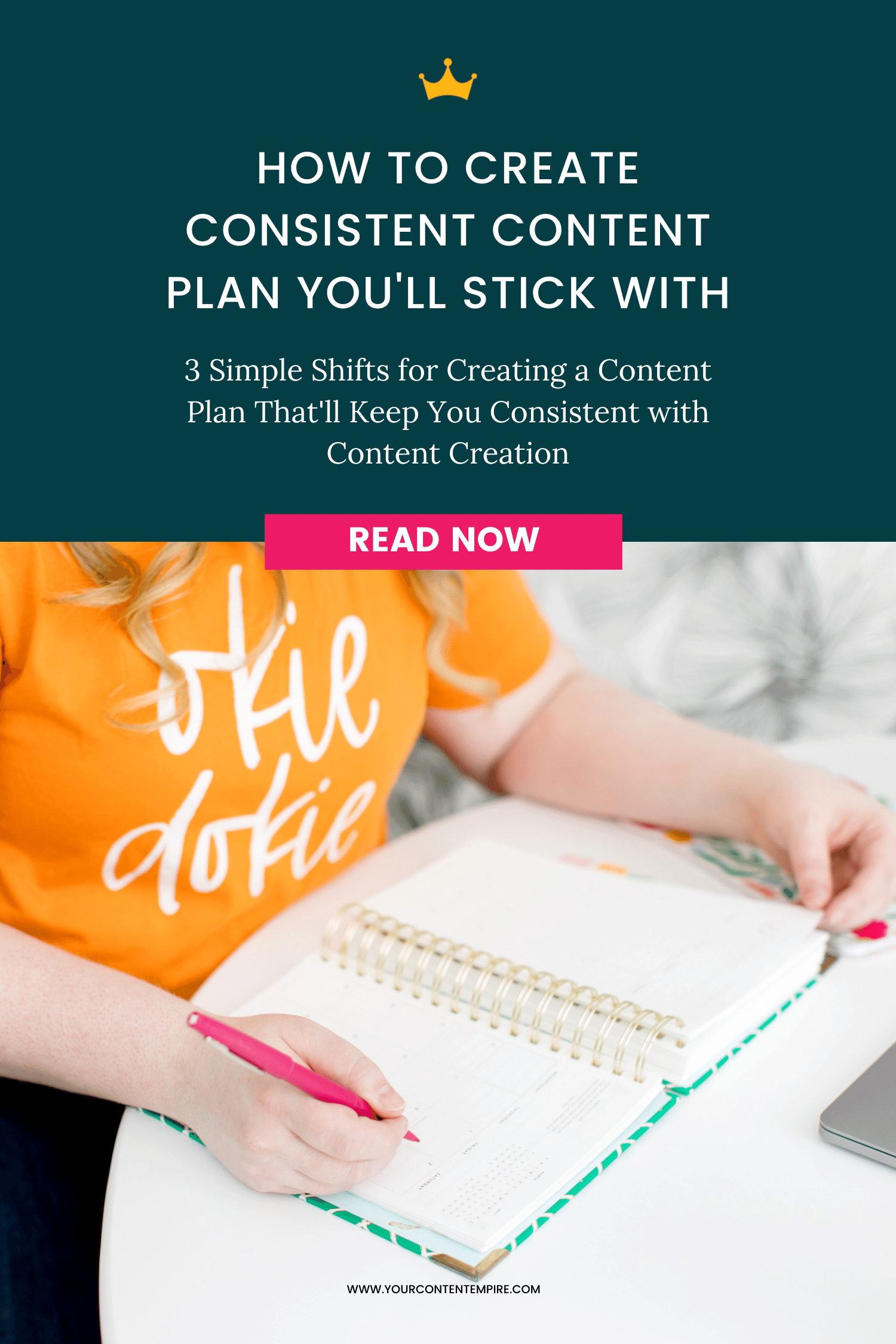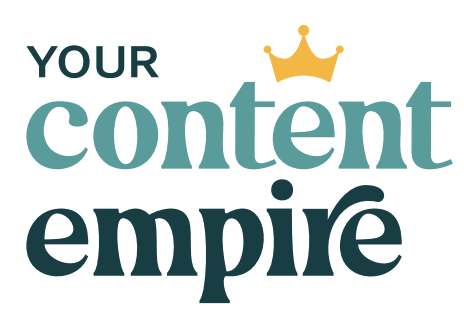Want to learn how to create consistent content? In this post, you'll learn my 3 simple shifts for creating a content plan you'll stick with.
Feel like anytime you create a content plan, you never end up following through?
Welcome to a very popular club on the internet full of super-smart business owners (just like you) who just haven’t found the right content planning process to make getting consistent with content practically inevitable.
So if you’ve got one too many unfinished content plans, I’ve got a process you have to know about.
So let’s talk content plans—particularly the content plans that just end up collecting dust and causing guilt. If you’re watching this, I’m betting you know exactly what I’m talking about.
Here’s the thing: you’ve got a ton of great ideas and a ton of value to offer. So that is not usually the problem.
Where I see most people struggle with content planning is that they’re trying to pack in too many of these great ideas into one content calendar.
Back-to-Back-to-Back-to-Back Feature Style.
Never giving themselves any room to breathe, to realistically do everything else that they have to do like running their business, taking care of customers, doing their client work, having a life.
Listen, I'm not about to tell you to stop being ambitious or stop setting ambitious goals if you want to (I'm a Capricorn, so ambitious is kinda my MO).
But I am going to show you 3 simple shifts (simple being the keyword) you can make to your content plan that’ll help you get consistent enough with your content to reach those ambitious business goals.
SHIFT #1 – SET YOUR MVO
Your MVO is known around these parts as your minimum viable output. And for your content this refers to the bare minimum content you need to publish on a regular basis. You can definitely create and publish more than this, but you’ll at least want to *know* what the minimum bar is.
Here’s an example:
Yes, it might be nice if every week, you could publish a new blog post, a newsletter to go with it, daily posts for Instagram and Facebook, plus a gaggle of images for Pinterest pinning too.
But maybe you know at the very least you can publish a new blog post every month, send a newsletter biweekly and pop a couple of posts a week up on your social media accounts.
Yes, you’d like to do more but at the very least this.
And sometimes when you’re super busy, that low bar lifestyle is where it’s gonna be.
This is your M.V.O. and it’s going to look different for everyone and it’s going to evolve over time.
I know for me it can also change from season to season depending on what’s going on in my business and life.
Here’s a little storytime: Once upon a time, sweet but naive past Hailey, full of good intentions but majorly short on time – planned an all the bells and whistles pre-launch campaign for my biggest launch of the year to run while I also happened to be trampsing around Europe for 4 weeks
Not only did I barely scrape by with publishing anything from that list, but I was stressed the entire time instead of being fully present on this once in a lifetime trip.
Here’s why this matters – it might not be an epic vacation for you, but it could be Saturday mornings you want to spend with your fam but you’re stuck working OR when you get slammed with client projects and your own stuff keeps falling to the bottom of the list.
The point is that knowing what your MVO is and using it as a backup plan for your content plans when things can’t go according to plan, will keep you from just going radio silent with your content – a total momentum killer.
So here’s what I want you to do:
- Create 2 lists.
- On list 1, you’ll write down everything you want to be doing content-wise? Anything you typically include content plans you normally create.
- Once you have that, on list 2, write down what you’d like to do at the very least. What would you be happy with? What’s the bare minimum you could show up?
Now the big question – how often are you even achieving the things from list one? Less than 50% of the time?
If that’s the case, it’s time to simplify!
I typically recommended starting with your MVO and then slowly working up to your ideal over time as it starts to feel easier and you get more consistent with your content.
SHIFT 2 – PICK A FEW PLATFORMS TO GO ALL IN
That brings us to Shift #2 which is to choose a few platforms to go all in on.
Gone are the days when it’s wise or even possible to be everywhere with your content.
Years ago, when I first started my sales funnel agency and was helping visionary business owners create their sales funnels, we’d come to that final phase of the project which is all about taking that brand spankin’ new funnel and driving as many of the right people as possible to it. That way we measure it, we can test and they can start to see some sales from the funnel asap.
So I’d start our strategy call off by asking them to list out all their dream spots where they’d like to show up – and they’d list everything they could think – then I’d include a step by step strategy for every single one of them.
You wanna guess how many of those early day clients were actually able to follow through on it? ALMOST ZERO of the ones who didn’t have a lot of help on standby.
So now that we’re wiser and smarter, we take what they’re already doing, optimize it with workflows and strategies and then add ONE new traffic activity a month. And the follow-through rate on that part of our funnel package is now through the roof.
So what does that mean for you? Well, it means that if you’re having trouble following through, maybe it’s time to prioritize on just one new spot (or even just one total) and then you can add on later, if you want.
When it comes to choosing – I like to take the EASE approach. Which is just my fancy little acronym’y way of breaking down the only 4 types of platforms and strategies you need to focus on for a well-rounded and profitable content strategy.
E – stands for educate which is usually some kind of blog, podcast or video that lives ON your website
A – stands for attract, which refers to one platform that’s designed to get your content and expertise in front of new eyeballs
S – which means sell and refers to one strategy for selling your offers, this might be an evergreen sales funnel, launches, or something else.
And finally our second E – which is one platform that’s designed for having 2-way dialogue with your existing community.
If those are the only 4 you do and you prioritize doing them really really well. You won’t have to do anything else and your follow-through will be much more consistent than it would be if you were doing the average 13+ platforms and strategies that most business owners attempt.
So over to you! What platforms are you prioritizing in your content plan?
SHIFT #3 – SET UP A SIMPLE MEASUREMENT SYSTEM
That brings us to our final shift on how to create a content plan you’ll stick with: setting up a simple measurement system.
One of the biggest reasons business owners don’t stick with their content plans comes down to motivation. Have you ever found yourself feeling stuck on that content hamster wheel, you finally get a new post published and before you even get a chance to breathe, it’s time to create the next one? And what’s even worse is that it feels like nobody saw the last post so it feels like you’re creating for no one? Talk about a motivation killer.
One of the best ways to give yourself a true perspective on what’s working and what’s not is to set up a simple measurement system for your content. That way, you can understand the real picture of how your content is performing even if no one is commenting on it.
And if the numbers are low, it gives you the insight you need to pivot your strategy. Like maybe no one’s seeing your latest post because you aren’t really doing your part to promote it? I’ve definitely been in that situation before.
Now you don’t have to get complicated with it but for every piece of content you publish, write down where you post it, and what metrics you have access to.
- The main things we want to measure for social are: # impressions, # traffic, # engagements
- The main things we want to measure for blog content are: #views #source of those views
- The main things we want to measure for emails are: #clicks
You can get a lot more complicated than this but it can also be just as simple as this too.
So your take action challenge for this shift is this: Next time you publish a piece of content, schedule 5 minutes 7 days later to go back and measure it. That’s all ya gotta do.
So ready to create a follow-through proof content plan? Let’s recap your action steps:
- Step 1 – Set your MVO – a.k.a. your minimum viable output
- Step 2 – Pick a few platforms to do really really well
- Step 3 – Pair your planning process with a measurement system
And if you don't have a great content planning template, you can take the free Consistent Content Quiz here to put these tips into practice. And let me know in the comments which of the 3 steps you most need to use.











